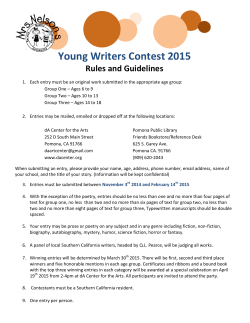
Relational Data Analysis
Relational Data Analysis
Gunther Schmidt1
Institute for Software Technology, Department of Computing Science
Federal Armed Forces University Munich
e-Mail: Schmidt@Informatik.UniBw-Muenchen.DE
Abstract. Given a binary relation R, we look for partitions of its row
set and its column set, respectively, that behave well with respect to
selected algebraic properties, i.e., correspond to congruences related to R.
Permutations are derived from these congruences that allow to rearrange
R visualizing the decomposition.
1
Introduction
Known and new methods of decomposing a relation are presented together with
methods of making the decomposition visible. Such aspects as difunctionality,
Moore-Penrose inverses, independence and line covering, chainability, game decompositions, matchings, Hall conditions, term rank, and others are handled
under one common roof.
1
2
0 0
2
0 0
3 1 0
4 0 0
5 0 0
6 1 0
7 0 0
0 0
8
A=
9 0 0
10 0 0
11 0 0
12 0 0
13 0 0
0 1
14
15 0 0
3
4
5
6
0 0 0 1
0 1 0 0
0 0 0 0
0 0 1 0
0 0 0 0
0 0 0 0
0 1 0 0
0 0 0 0
1 0 0 1
0 0 0 0
0 0 0 1
0 0 0 0
0 0 1 0
0 0 0 0
0 0 0 0
0 0 1 0 0 0
16
0 0 0 0 0 1
17
An initial example
1
7
8
9 10 11 12 13
0 0 0 0
0 0 0 0
0 1 0 0
0 0 0 1
0 0 0 0
0 1 0 0
0 1 0 0
0 0 0 0
0 0 0 0
0 0 0 0
1 0 0 0
0 0 0 0
0 0 1 0
0 0 0 1
1 0 0 0
0 0 0 0
0 0 0 0
of a sparse
0 0 0
0 0 0
0 0 0
0 0 0
0 0 0
0 0 0
0 0 0
0 0 0
0 0 0
0 0 0
0 0 0
0 0 0
0 0 0
0 0 0
0 0 1
0 0 1
0 0 0
relation
One area of application is multicriteria decision making. There, relations are
given beforehand and one asks for dichotomies generated by the relation [1, 3]
1
Cooperation and communication around this research was partly sponsored by the
European COST Action 274: TARSKI (Theory and Application of Relational Structures as Knowledge Instruments), which is gratefully acknowledged.
following certain rational ideas. One may call this theorem extraction or theorem
formulation — as opposed to theorem proving. Once formulated, theorem provers
would certainly establish the theorem. But in practical situations it is more
important to find the theorem on which one is willing to base decisions.
Much of the basic approach can be demonstrated by the initial example of a
sparse boolean matrix A, which looks rather randomly distributed. It is a big
problem in marketing, e.g., to analyze such raw data so as to finally arrive at
Arearranged . We have visualized that certain theorems are valid, namely that
elements of {1, 9, 11, 15, 16, 17} are only related to elements from {3, 6, 7, 13},
etc.
3
6
0 1
9
1 1
11 0 1
15 0 0
16 1 0
17 0 1
2 0 0
0 0
3
Arearranged = 6
0 0
7 0 0
4 0 0
13 0 0
14 0 0
0 0
5
8 0 0
1
10
12
7 13
0
0
1
1
0
0
0
0
0
0
0
0
0
0
0
0 0 0
0 0 0
0
0
0
1
1
0
0
0
0
0
0
0
0
0
0
0
0
1
4
8
2
5
9 10 11 12
0
0
0
0
0
0
0
1
1
0
0
0
0
0
0
0
0
0
0
0
0
0
0
1
0
0
1
0
0
0
0
0
0
0
0
0
0
0
0
0
0
1
1
1
0
0
0
0
0
0
0
0
0
0
0
0
0
0
0
0
0
0
0
1
0
0
0
0
0
0
0
0
0
0
0
0
0
0
1
1
0
0
0
0
0
0
0
0
0
0
0
0
0
0
0
0
1
0
0
0
0
0
0
0
0
0
0
0
0
0
0
0
1
0
1
0
0
0
0
0
0
0
0
0
0
0
0
0
0
0
0
0
0
0
0
0
0
0
0
0
0
0
0
0
0
0
0
0
0
0
0
0
0
The initial example partitioned and rearranged
Having knowledge of this type may obviously be considered a major marketing
advantage. Our basic question is, therefore: Are there methods to generate such
theorems? One will certainly not blindly generate all theorems and scan them in
some sort of a Laputa method [7] for interesting ones. Rather, there should be
some concept as to how these theorems might look like. In the environment of
RelMiCS, one will concentrate on “relation-algebraic theorem patterns”. Several
of these have been investigated and formulated as ontologies. By ontology we
mean relational games, irreducibility, line covering, or matching concepts, e.g.
With one of these ontologies, the relation in question is analyzed.
The full report underlying this article, obtainable via
http://ist.unibw-muenchen.de/People/schmidt/DecompoHomePage.html,
strives to provide the methodological basis together with a toolkit for the task of
decomposing relations in various application disciplines. This report is not just
a research report but also a Haskell program in literate style sufficient to run
the programs.
2
Prerequisites and Tools
We have used Haskell [2] as the underlying programming language. It is a purely
functional language, and it is currently widely accepted in research and university
teaching. For more information see the Haskell WWW site at
URL: http://www.haskell.org/.
In the example presented in the introduction, the resulting permutation has only
been shown via the permuted row and column numbers. The permutations, however, should be fully available in the program. There, they may be given as a
function, decomposed into cycles, or as a permutation matrix. Either form has
its specific merits. Sometimes also the inverted permutation is useful. Therefore, types and functions to switch from one form to the other, and to apply a
permutation to some list are provided for. Also a basic technique is introduced
determining permutations from partitions. Let, for example, a list of partitioning
subsets be given as
[[False,True, False,True, False,False],
[False,False,True, False,False,True ],
[True, False,False,False,True, False]]
We are interested to obtain a permutation like [5,1,3,2,6,4], which directs
True entries of the first row to the front, followed by True entries of the second
row, etc.
Relations are throughout handled as rectangular Boolean matrices. Often we
represent their entries True by 1 and False by 0 when showing matrices in
the text. The basic relational operators &&&, |||, ***, <== for intersection,
union, composition, containment, etc., of relations are all formulated in Haskell.
3
Congruences
Whenever some equivalence behaves well with regard to some other structure,
we are accustomed to call it a congruence. This is well-known for algebraic structures, i.e., those defined by mappings on some set. We define it correspondingly
for the non-algebraic case, including heterogeneous relations. Let R be a relation and Ξ, Θ be equivalences on the source, resp. the target set of that relation.
Then the pair (Ξ, Θ) is called a R-congruence if Ξ ; R ⊆ R; Θ.
We have formulated a generalisation of Birkhoffs famous theorem on the lattice
of congruences for algebraic structures, extending it to relational structures.
Proposition 1. Let some finite heterogeneous relation R be given. Then all
R-congruences (P, Q) which satisfy both, R ; RT ⊆ P and RT ; R ⊆ Q, form a
complete lattice, the least element of which is (Ξ, Θ) := ((R; RT )∗ , (RT; R)∗ ), the
pair of natural congruences wrt. R.
Proof : Among other items, the proof has to show that the set
{(P, Q) | (P, Q) is an R-congruence satisfying R; RT ⊆ P and RT ; R ⊆ Q}
is ∩-hereditary:
(P1 ∩ P2 ); R ⊆ P1 ; R ∩ P2 ; R ⊆ R; Q1 ∩ R; Q2
⊆ (R ∩ R; Q2 ; QT1 ); (Q1 ∩ RT ; R; Q2 ) using Dedekind’s rule
⊆ R; (Q1 ∩ Q2 ; Q2 ) = R; (Q1 ∩ Q2 )
Every congruence leads to a partition in equivalence classes, and these partitions
in turn give rise to the permutations we compute for presentation purposes.
4
Difunctional Decomposition
Two different cases of decomposition will be distinguished: For heterogeneous
relations between two sets — be it that they have equal cardinality —, we will
permute rows and columns independently and for homogeneous relations rows
and columns will be permuted simultaneously.
In the introductory example, difunctionality leads to an important decomposition. It groups rows as well as columns according to the “natural congruence”.
A relation R is called difunctional if R ; RT ; R = R. For every relation R, the
least difunctional relation containing it is well defined and we define (according
to J. Riguet, [4]) the difunctional closure as
hdifu (R) := inf {H | R ⊆ H with H difunctional}
We also ask for the practical aspects of this definition, which has long been
discussed and is known among numerical analysts. To describe the main property
of any diagonal block of the rearranged initial example, let a relation R be
given that is conceived as a chessboard with dark squares or white according
to whether Rik is True or False. A rook shall operate on the chessboard in
horizontal or vertical direction; however, it is only allowed to change direction
on dark squares. Using this interpretation, a relation R is called chainable if
the non-vanishing entries (i.e., the dark squares) can all be reached from one
another by a sequence of “rook moves”, or else if hdifu (R) = . The diagonal
blocks mentioned are chainable when considered as a separate matrix. It is easy
to prove that a total and surjective relation R is chainable precisely when its
so-called edge-adjacency K := ∩ R ; RT is strongly connected.
The concept of being difunctional is related to linear algebra for numerical problems. A relation G is called a Moore-Penrose inverse of A if the following
four conditions hold A; G; A = A, G; A; G = G, (A; G)T = A; G, (G; A)T = G; A.
Moore-Penrose inverses are uniquely determined provided they exist. The MoorePenrose inverse of a difunctional matrix always exists and turns out to be its
converse.
5
Line Covering and Independence
Some relations may be decomposed in such a way, that there is a subset of row
entries that is completely unrelated to a subset of column entries. In this context,
a relation A may admit vectors x and y (with =
/ x=
/ or =
/ y=
/ to avoid
degeneration), such that A;y ⊆ x or, equivalently, A ⊆ x; y T . Given appropriate
permutations P of the rows, and Q of the columns, respectively, we then have
∗
P ; A; QT =
Q; y =
.
P;x =
∗ ∗
Given A; y ⊆ x, to enlarge the -zone is not so easy a task, which may be seen
in the case of the identity relation : All shapes from 1 × (n − 1), 2 × (n − 2),
. . . (n − 1) × 1 may be chosen. To avoid this counter-running, one usually studies
this effect with one of the sets x and y negated. So we consider pairs of subsets
(s, t) taken from the domain and from the range side and define
(s, t) is a line covering
:⇐⇒ A; t ⊆ s.
(s, t) is a pair of independent sets
:⇐⇒ A; t ⊆ s.
For the moment, call rows and columns lines. Then we are able to cover all
entries 1 by |y| vertical plus |x| horizontal lines. Given a relation A, the term
rank is defined as the minimum number of lines necessary to cover all entries
1 in A, i.e. min{|s| + |t| | A; t ⊆ s}.
A11
;
⊆
. Hoping to arrive at fewer lines than the
Consider
A21 A22
columns of A11 and the rows of A22 to cover, one might start a first naive attempt
and try to cover with s and t but with row i, e.g., omitted. If (s, t) is already
minimal, there will be an entry in row i of A22 containing a 1 . Therefore, A22
is a total relation. In the same way, A11 turns out to be surjective. But we may
also try to get rid of a set x ⊆ s of rows and accept that a set of columns
be added instead. It follows from minimality that regardless of how we choose
x ⊆ s, there will be at least as many columns necessary to cover what has been
left out. For a relation A and a set x, we therefore say that x satisfies the Hall
condition if |z| ≤ |AT;z| holds for every subset z ⊆ x. If we have a line covering
with |s| + |t| minimal, then AT11 as well as A22 will satisfy the Hall-condition.
We will later find minimum line coverings and maximum independent sets without just checking them all exhaustively. We postpone this, until further prerequisites are at hand and concentrate on the following aspect.
Proposition 2. Let a finite relation A be given. Then A is either chainable
or it admits a pair (s, t) which is nontrivial, such that both s, t as well as s, t,
constitute at the same time a pair of independent sets and a line covering.
Difunctionality and line coverings are related in the following way.
Proposition 3. A relation A admits a pair (x, y) such that (x, y) and (x, y) are
line coverings if and only if its difunctional closure admits these line coverings.
6
Game Decomposition
While so far heterogeneous relations have been treated by permuting their rows
and columns independently, we now specialize to the homogeneous case and apply permutations simultaneously. There is a well-developed theory of standard
iterations for Boolean matrices in order to solve a diversity of application problems such as matching, line covering, assignment, games, etc. We will present a
general framework for executing these iterations.
In all of these cases, we need two antitone mappings between power sets, which
we call σ : P(V ) → P(W ) and π : P(W ) → P(V ), according to [5, 6]. In
case V = W , let an arbitrary homogeneous relation B : V ↔ V be given with
π(x) = σ(x) = B ; x. Two players are supposed to make moves alternatingly
according to B in choosing a consecutive arrow to follow. The player who has no
further move, i.e., who is about to move and finds an empty row in the relation
B, or a terminal vertex in the graph, has lost.
0 0
1 1 0
1 1
2
3 0 1
4 0 0
0
5
4
6
2
3
1
0
0
5
6
1
2
3
4
5
6
0
0
0
1
1
0 0 0
0 0 0
0
0
0
0
1
1
0
0
0
0
0
0
1
1
0
0
0
0
0
0
1
0
0
0
0
0
0
0
Situations in a game starting with a pile of 6 matches
Such a game is easily visualized by taking a relation B represented by a graph,
on which players have to determine a path in an alternating way. We study the
Nim game starting with 6 matches from which we are allowed to take 1 or 2.
We have a homogeneous relation, and we easily observe how with equalities in
an alternating pattern an iteration evolves
⊆ B;
= B; B;
⊆ B; B; B;
= . . . ⊆ . . . ⊆ B; B; B;
= B; B;
⊆ B;
= .
The limit of the iteration is characterised by the formulae a = π(b) and σ(a) = b,
which this time turn out to be a = B ; b and B ; a = b. In addition, we will always
have a ⊆ b. The smaller set a gives loss positions, while the larger one then
indicates win positions as b and draw positions as b ∩ a. This is visualized by the
following diagram for sets of win, loss, and draw, the arrows of which indicate
moves that must exist (the thick black arrows), may exist (the thin arrows), or
are not allowed to exist (the crossed out grey arrows).
no further move
possible
Loss
Win
result a of iteration
Draw
result b of iteration
Decompositions into sets of winning, draw, and losing positions
Proposition 4. Any finite homogeneous relation may by simultaneously permuting rows and columns be transformed into a matrix satisfying the following
basic structure with square diagonal entries:
∗
total ∗
total
∗
∗
Of course, the win or the loss zone may contain no rows. If the win zone is
nonempty, so is the loss zone. Nevertheless, the subdivision into loss/draw/win
groups is uniquely determined, and indeed
a=
=
total
7
total
∗
∗
∗
∗
;
b=
=
total
total
∗
∗
∗
∗
;
Matching and Assignment
An additional antimorphism situation is known to exist in connection with
matchings and assignments. Let two matrices Q, λ : V ↔ W be given, where
λ ⊆ Q is univalent and injective, i.e. a matching — possibly not yet of maximum
cardinality.
We consider Q to be a relation of sympathy between a set of boys and a set of
girls and λ the set of current dating assignments, assumed only to be established
if sympathy holds. We now try to maximize the number of dating assignments.
Definition 5. Given the (possibly heterogeneous) relation Q, we call the relation
λ a Q-matching provided it is a univalent and injective relation contained in
Q, i.e., if
λ ⊆ Q
λ ; λT ⊆ ,
λT ; λ ⊆ .
An iteration with π(w) := λ; w and σ(v) := QT ; v will end with two vectors (a, b)
satisfying a = π(b) and σ(a) = b as before. Here, this means a = λ;b and b = QT;a.
In addition a = Q ; b. This follows from the chain a = λ ; b ⊆ Q ; b ⊆ a, which
implies equality at every intermediate state. Only the resulting equalities for a, b
have been used together with monotony and the Schr¨
oder rule to obtain this
decomposition.
We find out that the pair a, b is an inclusion-maximal pair of independent sets
for Q, or else a, b is an inclusion-minimal line covering. As of yet, a, b need
not be an inclusion-maximal pair of independent sets for λ, nor need a, b be an
inclusion-minimal line covering for λ! This will only be the case, when in addition
b = λT ; a.
It is thus not uninteresting to concentrate on the condition b = λT ; a. After
having found some matching relation and applying the iteration, it may not
yet be satisfied. So let us assume b = λT ; a not to hold, which means that
⊇
b = QT ; a λT ; a.
=
/
We make use of the formula λ; S = λ; ∩ λ; S, which holds since λ is a univalent
relation. The iteration finally ends with equations b = QT ; a and a = λ ; b. This
easily expands to
b = QT ; a = QT ; λ; b = QT ; λ; QT ; a = QT ; λ; QT ; λ; QT ; a . . .
from which the last but one becomes
b = QT ; a = QT ; λ; b = QT ; λ;
= QT ; (λ;
∪ λ; QT ; (λ;
∩ λ; QT ; a = QT ; (λ;
∪ λ; QT ; a)
∪ λ; QT ; a))
indicating how to prove that
b = (QT ∪ QT ; λ; QT ∪ QT ; λ; QT ; λ; QT ∪ . . . ); λ;
⊆ b, we may thus find a point in
If we have λT ; a =
/
(QT ∪ QT ; λ; QT ∪ QT ; λ; QT ; λ; QT ∪ . . . ); λ;
∩ λT ; a
which leads to the well-known alternating chain algorithm.
When showing the result, some additional care will be taken concerning empty
rows or columns in Q showing them at the first or at the last position, respectively. The Hall condition is made visible by arranging λ in a diagonal shape and
by introducing an additional subdividing line. In principle, this gives a 4 by 4
pattern. Either or all of the first 3 row zones, or the last 3 column zones may be
empty.
3 15 13 17
0 0
16 0 0
1 0
6
12 0 0
14 1 1
1 1 0
2 1 1
4 0 0
0 0
5
10 0 0
3 1 0
8 0 0
9 1 0
11 0 0
0 0
13
15 0 0
17 1 0
4
9 14
1
5
7 12
8 16
2 11
6 10
0 0 0 0 0 0 0 0 0 0 0 0 0 0 0
0 0 0 0 0 0 0 0 0 0 0 0 0 0 0
1 0 0 0 0 0 0 0 0 0 0 0 0 0 0
0 0 1 0 0 0 0 0 0 0 0 0 0 0 0
0 0 0 0 0 0 0 0 0 0 0 0 0 0 0
0 1 0 0 0 0 0 0 0 0 0 0 0 0 0
0 0 0 0 0 0 0 0 0 0 0 0 0 0 0
1 1 0 0 0 0 0 0 0 0 0 0 0 0 0
0 1 0 0 0 0 0 0 0 0 0 0 0 0 0
0 0 1 0 0 0 0 0 0 0 0 0 0 0 0
0 0 0 1 0 0 0 0 1 0 0 0 1 0 0
0 0 0 0 1 0 0 0 0 0 0 0 0 0 0
0 0 0 0 0 1 0 0 0 0 0 0 0 0 0
0 0 0 0 0 0 1 0 0 0 0 0 0 0 0
0 0 0 0 0 0 0 1 0 0 0 0 0 0 0
0 0 1 0 0 1 0 0 1 0 0 0 0 0 0
0 0 1 0 0 1 0 0 0 1 0 0 0 0 0
18
0 0 0 0 0 0 0 0 0 0 0 0 1 0 0 0 0
19
0 1 0 0 1 0 0 0 1 0 1 0 0 1 1 0 0
Arbitrary heterogeneous relation with a rearrangement according to
a cardinality-maximum matching — the diagonals
7
Proposition 6. Any given heterogeneous relation Q admits a cardinality-maximum matching λ ⊆ Q. By independently permuting rows and columns they can
jointly be transformed into matrices of a 2 by 2 pattern with not necessarily
square diagonal blocks of the following form:
T
Q=
Hall
∗
Hall
λ=
univ. + surject. + inject.
univ. + total + inject.
Looking back, we see that we have not just decomposed according to a pair of
independent sets, but in addition ordered the rest of the relation so as to obtain
matchings.
8
Conclusion and Outlook
Based on such investigations, it is possible to automatically develop theories
combined with some relations, starting from a given ontology (difunctionality,
game, e.g.). When applying a relational decomposition, this theory will change
as it afterwards fits into the given ontology and, thus, includes the necessary
predicates and theorems.
The following diagram shows the idea. There are concrete relations given and
the sparse theory with which one may work on these. By this we mean hardly
more than asking whether two elements are related. There is, however, also
an ontology concerning games, irreducibility, or difunctionality, e.g. What we
are constructing is in a sense the pushout. Afterwards, the given model may
be viewed with the win-loss-draw structure, e.g., which the game ontology has
provided. Then the theory will also contain certain closed formulae describing
what holds between the new items.
Sparse theory
|=
↓
Ontology-enhanced theory
Given model
↓
|=
Result model
With the methods presented it is possible to analyze a given relation with regard to different concepts and to visualize the results. Some programs are more
efficient, others less. This was not a matter of concern in this paper, though. We
had in mind data of a size not too big to be handled and even visualized for
presentation purposes.
There is another point of possible criticism that matters more. Should the relations handled stem from rather fuzzy sources, taken by some α-cut, e.g., the
results will heavily depend on single entries of the relation. On the other hand,
such a single entry may be a rather “weak” one as to its origin from the α-cut as
it has hardly passed the threshold. In the approach chosen, therefore, we have
extremely high sensitivity depending on the initial data. This is a feature, one is
usually not interested in. Rather, one would highly estimate results which stay
more or less the same as data are changed only moderately. This would give
more “meaning” to the results and would make it easier to base decisions on
them.
Nonetheless, we hope that our exposition will lead to future research. We have
scanned a diversity of topics for their algebraic properties. On several occasions,
we have replaced counting arguments by algebraic ones. Our hope is that these
algebraic properties will be of value in the following regard: Only recently, fuzzy
relations have been investigated with more intensity. There, the entry of the
matrix is not just 1 / 0 or yes/no. Instead, coefficients from some suitable
lattice are taken. In this way it is possible to express given situations in more
detail. Astonishingly, much of the algebraic structure of relation algebra still
remains valid. In this modified context an investigation should be done using
fuzzy relations. Reduced sensitivity of results with respect to given data may be
hoped for.
Acknowledgment. The author gratefully acknowledges fruitful discussions
with Michael Ebert as well as detailed comments of the referees.
References
ˇ, N., Eds. Relational Data Mining. Springer-Verlag,
1. Dˇ
zeroski, S., and Lavrac
2001.
2. Hudak, P., Jones, S. L. P., Wadler, P., et al. Report on the programming language Haskell, a non-strict purely functional language, version 1.2. ACM SIGPLAN
Notices 27, 5 (1992). See also http://haskell.org/.
3. Kitainik, L. Fuzzy Decision Procedures With Binary Relations — Towards a Unified Theory, vol. 13 of Theory and Decision Library, Series D: System Theory,
Knowledge Engineering and Problem Solving. Kluwer Academic Publishers, 1993.
4. Riguet, J. Quelques propri´et´es des relations difonctionelles. C. R. Acad. Sci. Paris
230 (1950), 1999–2000.
¨ hlein, T. Relationen und Graphen. Mathematik f¨
5. Schmidt, G., and Stro
ur Informatiker. Springer-Verlag, 1989. ISBN 3-540-50304-8, ISBN 0-387-50304-8.
¨ hlein, T. Relations and Graphs — Discrete Mathematics
6. Schmidt, G., and Stro
for Computer Scientists. EATCS Monographs on Theoretical Computer Science.
Springer-Verlag, 1993. ISBN 3-540-56254-0, ISBN 0-387-56254-0.
7. Swift, J. Gulliver’s travels, 1726.
© Copyright 2025










